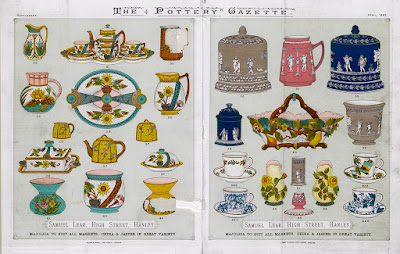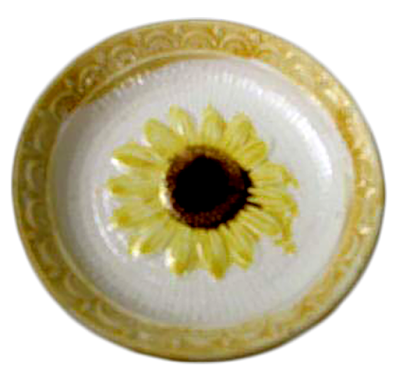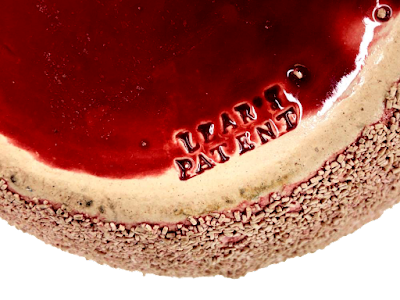Probably the single most famous piece created at the Lear Pottery is the sunflower oyster plate seen above, but as is true of the smaller potteries of Staffordshire, little is known about the company that created it.
Samuel Lear had a brief but memorable career in the manufacture of majolica. Born in 1853 near Hanley, like so many before him, he was a child of the Staffordshire potteries. His father worked as an operator of the kilns at one of the nearby potteries. At the age of eight he joined his father's trade as a pottery ovenman. In 1871 the ambitious young man was registered in the census as a "potter's fireman." By the age of 21 he opened his own business in Hanley, believed to initially be a pottery warehousing business but is believed to have expanded to decorating china made by other potteries. About 1876 he opened his own pottery at the Mayer Works, manufacturing all forms of earthenware.
In 1881 he also began the manufacture and advertisement of majolica, largely in the Aesthetic taste. The following year he expanded his pottery with additional facilities.
"Samuel Lear erected a small china works on part of the site of the old manufactory, which included as warerooms and offices the residence of Mayers. Mr. Lear produced domestic china and, in addition, decorated all kinds of earthenware made by other manufacturers - a specialty being spirit-kegs. He added to his Mayer Street works a new manufactory, built by himself in 1882, in the High Street and there carried on a successful manufacture of ordinary china, majolica, ivory body earthenware, and Wedgwood-type jasper ware."–Jewitt's Ceramic Art of Great Britain 1800-1900
The rope and lily pattern was another one originally created at another pottery. This design was registered by James Edwards and Son.
When Edwards & Son foundered in 1881, Lear purchased the rights and the molds for the pattern and began producing it in large quantities in majolica expanding its design motifs to different shapes.
One of the earliest registered Lear majolica patterns is the crane pitcher below from 1881.
Another registered original design from Lear, this in the aesthetic taste, is Sunflower. While the best known piece of this pattern is the oyster plate at the top of the page there was a complete line created in the pattern.
Lear manufactured other original majolica designs, including several modern designs, with designer Christopher Dresser.
Lear also created utilitarian majolica ware such as the ink well, oyster plate and syrup below and work in the Barbotine manner like the basket below.
By 1886 Lear developed serious financial problems and in January of 1887 creditors named him in bankruptcy proceedings. Lear plotted to bilk his creditors and leave England. He sent his family ahead to New South Wales in Australia and quietly sold his Mayer Works pottery to Thomas Forester, who most certainly continued the manufacture of Lear products.
Lear sent the money from the sale abroad to his family, boarded a ship and set sail to join them. His family settled in Dunedin, New Zealand, near the site of the Milton Pottery. He worked at Milton in some capacity for an unknown period of time but left Dunedin in an unsuccessful search for better employment.
He arranged passage home by working his way back as a crew hand on a schooner called The Colonist. At 11:00 on the morning of August 31, 1888 the ship lost its rudder and ran aground on the rocks off Wellington at the site of the Pencarrow lighthouse in the north island of New Zealand, Te Ika-a-Māui. Three of the four men aboard were killed, Lear among them. His body was never found.
From the Lyttelton Times, September 12, 1888
From the Evening Post, September 12, 1888:
"Mr. Luke Adams, of the Sydenham Pottery, has stated to the Lyttelton Times his belief that the fragment of Post Office Savings Bank circular, found by Mr. Whitely King near the scene of the wreck is sufficient proof of the identity of the man who was known to be on board the vessel and believed to be a potter from Dunedin. A potter named Samuel Lear who said he came from the Milton (Otago) potteries called upon him about two months ago, in search of employment. He had also been up at Springfield on the same quest. Mr. Adams was unable to give him employment then, but gave him sufficient funds to take him back to his wife and children. This was done at the man’s own request. Since then Mr. Adams has written to Milton asking about the man but got no reply from the man himself. From a friend ... a reply has been sent that Lear is supposed to have gone to Sydney. Lear had evidently taken the first employment offering–as a hand aboard the ill fated vessel."
From the Evening Post, September 17, 1888
His coat was also found among the wreckage with a photo and a handkerchief embroidered "S. Lear" in the pocket. Samuel Lear was 35 years old at the time of his death.
















































































